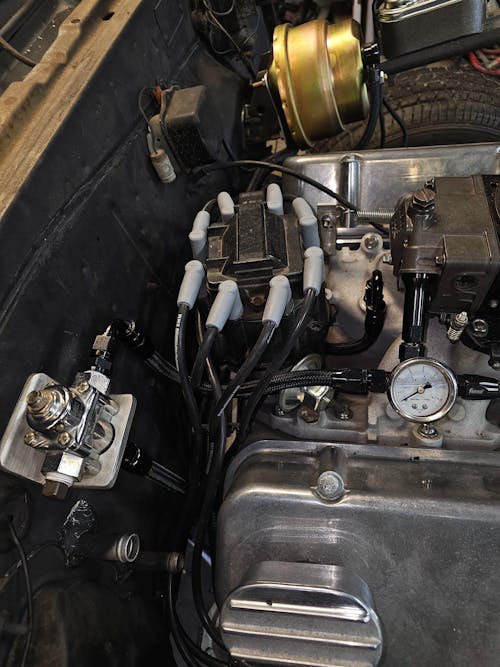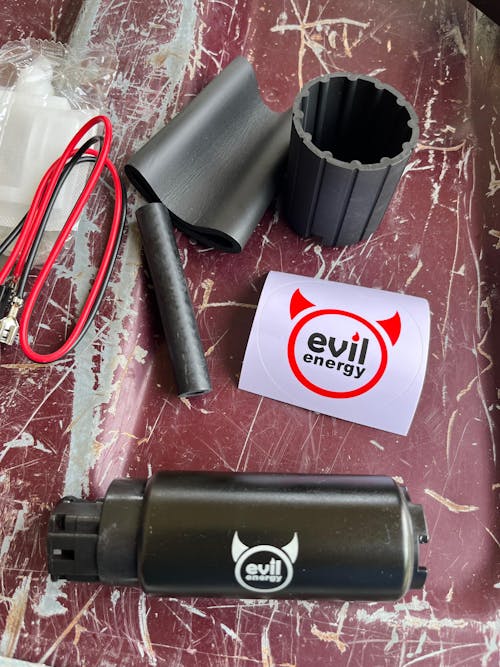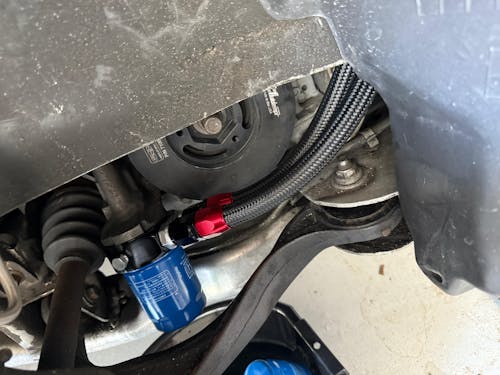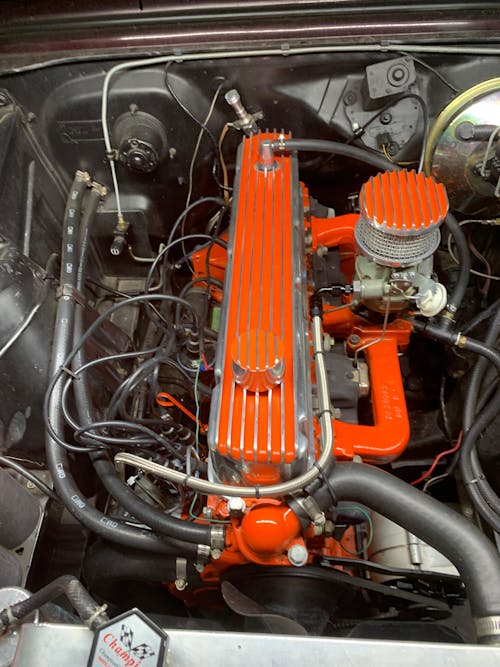15 Gallon Fuel Cell & PTFE Fuel Lines Guide: Size, Fitment, Hose & AN Fittings
A 15-gallon fuel cell typically envelopes ~25×18×10 in and works well for drift, track day, street-strip, LS swaps, and classic replacements. For plumbing, a PTFE fuel line hose is the safest all-round choice (E10/E85 compatible). Most street/track builds run a 6AN PTFE fuel line or 8AN PTFE fuel line; high-flow combos use a 10AN PTFE fuel line. Always match fuel tank hose size, pump flow, regulator, and sender ohms (GM 0–90 / Ford 73–10 / 240–33).
For drift, track days, drag, LS swaps and classic replacements, a 15-gallon fuel cell hits a sweet spot: compact footprint, solid range, EFI/Carb flexible plumbing. Below we cover real sizes, if 15 gallons is 'good enough,' how it compares to gas tanks, and what it actually costs — with two owner installs to show what works (and what doesn’t).
How big is a 15-gallon fuel cell?
Most 15 gallon fuel cell units measure roughly 24–26-inch (L) × 17–19-inch (W) × 9–12-inch (H). Height decides trunk well clearance; verify ear spacing and drill points before you cut.
Fitment Checklist
-
Measure trunk inner L×W×H, spare-well depth, diff bump travel, and exhaust route.
-
Confirm port type/position (top-out vs bottom-sump).
-
Check sender ohms (GM 0–90Ω / Ford 73–10Ω / Universal 240–33Ω) for your gauge.
-
Plan a vent line with a rollover valve.
-
If you’ll run E85, pick PTFE fuel line hose (not CPE) end-to-end.
Pro Tip: 'Top-out' cells need pumps that can pull. 'Bottom-sump' cells pair best with pusher pumps mounted low and vertical for fast priming.
YouTube's Video One
square cell, install & prime fast
-
Key moments: sees -10AN ports & foam (2:39–4:11), custom mounts (5:14–5:31), pump vertical (6:57–7:09), instant fuel pressure (7:47–8:06).
-
Takeaway: square -10AN cells + low/vertical pump = easy priming; protect finish during install.
Will a 15-gallon fuel cell fit my trunk?
Measure inner length/width/height, spare-well depth, diff bump travel, and exhaust routing. Confirm the AN port size, sender ohms, and vent/rollover placement before purchase
| Shape | Capacity | Size(cm) (±5mm) | Size (inch) (L*W*H) | Inlet/Outlet Fitting | Mounting tab(inch) | Features |
|---|---|---|---|---|---|---|
| Cubic Models | 1 Gal | 17×21×18 | 7×6.75×8 | AN8 | 3.64 | Anti-Slosh Foam, No Sensor |
| 2.5 Gal | 21×21.5×25 | 8×8.25×10 | AN10 | 3.64 | Level Sensors (3-90Ω) & Anti-Slosh Foam | |
| 5 Gal | 30.5×30.5×21 | 12×12×8 | AN10 | 3.64 | Level Sensors (3-90Ω) & Anti-Slosh Foam | |
| 8 Gal | 37.5×31.7×26 | 15×12.5×10 | AN10 | 3.64 | Level Sensors (3-90Ω) & Anti-Slosh Foam | |
| 10 Gal | 42×42×23 | 9.05×16.53×16.53 | AN10 | 3.64 | Level Sensors (3-90Ω) & Anti-Slosh Foam | |
| 12 Gal | 50.5×45.5×23 | 19.9×18×9.05 | AN10 | 3.64 | Level Sensors (3-90Ω) & Anti-Slosh Foam | |
| 15 Gal | 50.5×45.5×25.5 | 19.88×17.91×10.03 | AN10 | 3.64 | Level Sensors (3-90Ω) & Anti-Slosh Foam | |
| 20 Gal | 61×50.5×25.5 | 24×20×10 | AN10 | 3.64 | Level Sensors (3-90Ω) & Anti-Slosh Foam | |
| Rectangular Models | 15 Gal | 75×30.5×23.5 | 30×12×9 | AN8 | 2.0 | Level Sensors (0-90Ω), No Anti-Slosh Foam |
| 19 Gal | 75×31×30.5 | 29.5×12×12 | AN8 | 2.0 | Level Sensors (0-90Ω), No Anti-Slosh Foam |
Is a 15-gallon tank good for a car?
Yes. A fuel cell 15 gallon balances weight, space, and range for most street/track builds. Expect roughly mpg × 15 miles per fill (e.g., 12 mpg ≈ 180 mi; 20 mpg ≈ 300 mi).
When a 15-gal fuel cell is ideal
-
Drift/HPDE/Street-Strip: needs foam/baffles to prevent starvation.
-
LS swaps & classic replacements: clean trunk layout, modern plumbing.
-
Mixed use: good range without killing cargo space.
When to size up
-
Long highway trips, endurance events, and overland.
-
Very high horsepower on ethanol with high flow demand.
YouTube's Video Two
Key MomentsA 15-gallon fuel cell transforms a car from short-session capable to truly streetable for ~1,000-mile road/track events, cutting down fuel stops while keeping the build compliant and reliable.
-
Upgrade 5 → 15 gal for real road range (2:03–5:20): shows why moving up to a 15-gallon fuel cell dramatically improves drive time between stops for drift, track, and endurance-style events.
-
2-day shipping mentions (3:24–3:39): availability and shipping speed make this a practical upgrade for builds on a deadline.
-
Tech prep essentials (9:14–13:03): covers compliance and safety basics—rubber hose ≤12-inch, transition to AN line, battery kill switch, belts within date, and required lights.
Fuel tank hose: why PTFE fuel line hose wins
PTFE fuel line hose handles heat, pressure and ethanol (E10/E85) better than traditional rubber/CPE. It resists vapor smell and lasts longer—ideal for a 15 gallon fuel cell install.
Benefits of PTFE
-
Ethanol safe: no softening/swelling with E85.
-
Low permeation: less fuel smell in the cabin/trunk.
-
Heat/pressure resistant: stable for EFI pressures.
-
Clean, consistent ID: predictable flow vs. some rubber liners.
Do: run PTFE from cell → pre-filter → pump → post-filter → regulator → rails → return.

Don’t: mix long lengths of rubber; many sanctioning bodies cap total rubber at ≤ 12 inches on a car.
6AN vs 8AN vs 10AN: which PTFE fuel line size should I choose?
For most street/track EFI builds, 6AN PTFE fuel line is plenty. Step up to an 8AN PTFE fuel line for higher-hp/E85 or long runs;the 10AN PTFE fuel line is for serious flow or lift-pump to surge/rails on big power.
Sizing Table (guideline)
| Use case | Fuel | Power (crank) | Recommended supply line | Notes |
| Street/HPDE NA V6/V8 | Gasoline | ≤450 hp | 6AN PTFE fuel line | Short runs, stable pressure |
| Street-strip NA/ mild FI | Gas/E10 | 450–650 hp | 6AN–8AN PTFE | Consider 8AN if long routing |
| Drift/Track E85 mid-hp | E85 | 400–600 hp | 8AN PTFE fuel line | E85 needs ~30% more flow |
| High hp FI / long return | Gas/E85 | 600–900 hp | 8AN–10AN PTFE | 10AN for lift → surge/rails |
| Extreme FI/drag | E85/Race | 900+ hp | 10AN PTFE fuel line | Parallel feeds / dual pumps |
Adapter reality: Many 15-gallon cells ship with -8AN or -10AN ports. Use straight/45/90 adapters to maintain sweep and avoid cavitation.
Top-out vs bottom-sump outlets
Top-outlet cells need a pump that can pull; bottom-sump favors pusher pumps and primes faster. Keep the pump low & vertical, add a pre-filter, and route a high vent with rollover valve.
Video One (diagnose → fix)
-
'Top-out + pusher pump' struggled → switched to bottom-sump; after plumbing, instant pressure (7:47–8:06).
-
Mounting: custom bracket, vertical pump, revised routing (6:57–7:09, 10:31–10:52).
-
Lesson: outlet type must match pump behavior; fittings choice (-10AN with -8AN system via adapters) matters.
How much does a 15-gallon fuel cell setup cost?
Plan $200–$350 for a 15-gallon fuel cell (foam/sender included), $100–$250 for PTFE fuel line hose and AN fittings, $120–$450 for the pump, and $60–$180 for filters/regulator. Certified race cells cost more.
Cost Breakdown
| Item | Typical range | Notes |
| 15-gallon fuel cell | $200–$350 | Check ports (-8AN/-10AN), sender ohms |
| PTFE fuel line hose + AN fittings | $100–$250 | Size per 6AN/8AN/10AN |
| Pump (in-tank/external) | $120–$450 | Match LPH to hp & fuel |
| Filters + regulator | $60–$180 | Micron spec per EFI/Carb |
| Mounts/plates/isolators | $40–$120 | Reinforce ear locations |
| FIA/SFI certified cell (opt.) | $700–$1,200+ | Required for sanctioned racing |
Why Choose Evil Energy
Most 15-gallon fuel cell setups cost $600–$1,200+ once you add hoses, fittings, and pumps. The Evil Energy 15-Gallon Fuel Cell Tank Kit changes that: for under $500, you get the cell, PTFE fuel line, and AN fittings in one complete package. No sizing guesswork (6AN/8AN/10AN options included), no hidden extras—just a ready-to-install solution that saves you time and money.
Summary
A 15-gallon fuel cell (~25×18×10 in) is a proven sweet spot for drift, track days, street-strip, LS swaps, and classic replacements. Pair it with a PTFE fuel line hose for E10/E85 compatibility, low permeation, and EFI safety. Size your lines by demand—6AN for most street/track builds, 8AN for mid-hp/E85 or long runs, 10AN for high-flow systems—and always match pump flow, regulator, and sender ohms (GM 0–90 / Ford 73–10 / 240–33).
If you want a turnkey, budget-friendly route, the Evil Energy 15-Gallon Fuel Cell Tank Kit bundles the cell + PTFE hose + AN fittings for under $500, beating typical piecemeal costs.
Shop the kit: Evil Energy’s Fuel Cell Tank Kit
FAQs - 15 Gallon Fuel Cell
Q1. How far can I go on 15 gallons?
A. Use range = mpg × 15. Example: 12 mpg ≈ 180 mi (aggressive tune/track), 20 mpg ≈ 300 mi (mild street).
Q2. Will a 15-gallon fuel cell fit my trunk?
A. Most are ~25×18×10 in. Measure inner L×W×H, spare-well depth, diff bump travel, and exhaust path. Confirm ear spacing, port size (-8AN/-10AN), top-out vs bottom-sump, and plan a high vent with rollover valve.
Q3. Is 15 gallons 'good enough' for mixed street/track?
A. Yes, for most builds: good range without killing cargo space. Size up (20–22 gal) if you do endurance highway, overland, or very high-hp E85.
Q4. Which PTFE fuel line size should I choose—6AN, 8AN, or 10AN?
A.
- 6AN: most EFI street/HPDE (≤~450 hp, short runs)
- 8AN: mid-hp/E85 or long routing (≈450–650+ hp or higher fuel volume)
- 10AN: high-flow feeds, surge tanks, big FI builds (≈900+ hp or dual pumps)
Q5. Why PTFE instead of rubber/CPE for a fuel tank hose?
A. PTFE is ethanol-safe (E10/E85), heat/pressure resistant, and low-permeation (less fuel smell). It’s the safest 'default' for EFI and modern fuels.
Q6. Do I need a fuel pressure regulator and filters?
A. Yes. Use a pre-filter before the pump, a post-filter after the pump, and a regulator matched to EFI or carb base pressure. Check micron ratings per system.
Q7. Top-out vs bottom-sump outlet—what’s the difference?
A. Top-out needs a pump that can pull (harder to prime). Bottom-sump suits pusher pumps mounted low and vertical, priming faster and more reliably.
Q8. Which sender ohms do I need for my gauge?
A. Common standards: GM 0–90Ω, Ford 73–10Ω, Universal 240–33Ω. Match sender to your gauge (or swap sender) for accurate readings.
Q9. Do I need foam/baffles in the cell?
A. Strongly recommended for drift/track to reduce slosh and starvation under lateral Gs.
Q10. What about tech/street rules on hose material?
A. Many rulebooks limit the total rubber hose ≤ 12 in for safety. Running PTFE end-to-end helps with compliance and longevity.
Q11. What else should I budget besides the cell and lines?
A. Pump, filters, regulator, mounts/plates/isolators, vent/rollover components, and wiring/relays. Certified race cells (FIA/SFI) cost extra if your sanctioning body requires them.
Q12. Is there a cost-effective way to buy everything together?
A. Yes—Evil Energy’s 15-Gallon Fuel Cell Tank Kit includes the cell + PTFE fuel line + AN fittings for under $500, reducing guesswork and saving time and money versus buying parts separately.
Related content




![[20FT] EVIL ENERGY PTFE Fuel Line Kit, complete black hose & fittings set, 180-day return](http://www.ievilenergy.com/cdn/shop/files/Test-2025-Evilenergy-125598065_165x.png?v=1742144807)
![[16FT] EVIL ENERGY PTFE Fuel Line Kit, black braided hose, fittings, free shipping & return](http://www.ievilenergy.com/cdn/shop/files/Test-2025-Evilenergy-125598171_165x.png?v=1742144807)
![CPE Fuel Line[25FT]](http://www.ievilenergy.com/cdn/shop/files/25FTCPE_FuelLine_165x.png?v=1735220649)
![CPE Fuel Line[20FT]](http://www.ievilenergy.com/cdn/shop/files/20FTCPE_FuelLine_165x.png?v=1735220649)
















